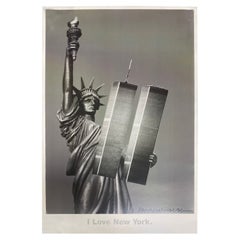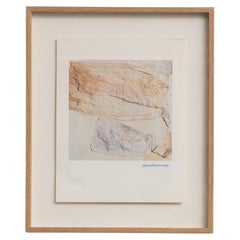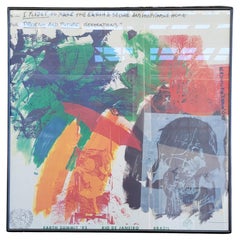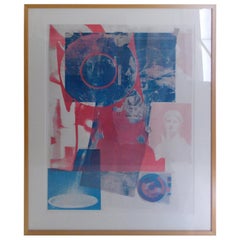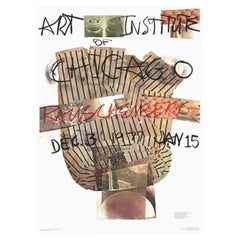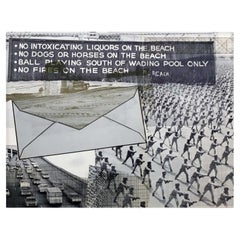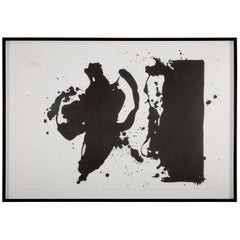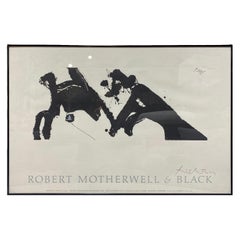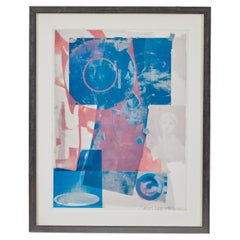Robert Rauschenberg Furniture
Robert Rauschenberg was one of the preeminent American artists of the 20th century, occupying a singular position that straddled the Abstract Expressionist and Pop art movements, drawing on key elements of each. An artistic polymath equally adept at painting, collage and silkscreening, Rauschenberg is best known for for the complex assemblages of found objects he termed “combines.”
Rauschenberg was born in Port Arthur, Texas, in 1925. He first began to seriously consider a career in art in 1947, while serving in the U.S. Marines. After leaving the service, he briefly studied art in Paris with support from the G.I. Bill, then moved to North Carolina to attend Black Mountain College, home to a flourishing cross-disciplinary art community. Among his peers there were choreographer Merce Cunningham and composer John Cage, both of whom became friends and artistic collaborators.
Relocating to New York in the mid-1950s, Rauschenberg was initially put off by what he perceived as the self-seriousness of the adherents of Abstract Expressionism, then the dominant movement in the New York art world. Like Andy Warhol and Roy Lichtenstein, Rauschenberg was drawn to the visual landscape of popular culture and mined its imagery for inspiration. He used unorthodox materials like house paint and tried novel techniques in his studio like running paper over with a car whose wheels he had inked. Shortly after his inaugural solo exhibition at Leo Castelli Gallery, which featured paintings and drawings, he pivoted to a new format, creating his first found-object combines, which became his signature. The most famous of these is the 1959 Monogram in which a taxidermied goat is surrounded by a car tire, recalling the way a person’s initials are interwoven in the design referred to by the title.
Later in the 1960s, Rauschenberg turned his attention to silkscreening, creating prints that feature iconic figures of the day, very much in line with the style and content of Pop art. One such work, 1965's Core, which was created to commemorate the Congress of Racial Equality, combines photographs of President Kennedy, an unidentified Native American man, and a statue of a Civil War soldier with images of highways, amusement parks, street signs, and other features of the built environment. A circular color-test wheel sits at the composition’s formal core, reflecting the work’s commentary on race and ethnicity.
Throughout the 1960s and ‘70s, Rauschenberg experimented with printing on unusual materials, such as Plexiglas, clothing and aluminum. Venturing even further afield, he created performance works, such as his 1963 choreographed piece “Pelican” and the 1966 film Open Score. In 1998, the Guggenheim Museum presented a large and comprehensive retrospective of Rauschenberg’s work, highlighting his influence on American art in the second half of the 20th century.
Find original Robert Rauschenberg art for sale on 1stDibs.
Early 2000s American Modern Robert Rauschenberg Furniture
Paper
1970s European Mid-Century Modern Vintage Robert Rauschenberg Furniture
Paper
Late 20th Century American Mid-Century Modern Robert Rauschenberg Furniture
Steel
1960s American Vintage Robert Rauschenberg Furniture
Paper
1970s American Vintage Robert Rauschenberg Furniture
Paper
1970s Vintage Robert Rauschenberg Furniture
Paper
1980s American Vintage Robert Rauschenberg Furniture
Paper
1990s American Modern Robert Rauschenberg Furniture
Porcelain
1960s American Modern Vintage Robert Rauschenberg Furniture
Paper
Late 20th Century Modern Robert Rauschenberg Furniture
Paper
1980s English Modern Vintage Robert Rauschenberg Furniture
Plexiglass, Paper
1980s American Vintage Robert Rauschenberg Furniture
Paper
Mid-20th Century American Mid-Century Modern Robert Rauschenberg Furniture
Paper
1970s American Mid-Century Modern Vintage Robert Rauschenberg Furniture
Paper
Late 20th Century French Modern Robert Rauschenberg Furniture
Paper
20th Century Robert Rauschenberg Furniture
Paper
1960s American Mid-Century Modern Vintage Robert Rauschenberg Furniture
Paper
Late 20th Century American Modern Robert Rauschenberg Furniture
Metal
1980s American Vintage Robert Rauschenberg Furniture
Paper
1980s Unknown Modern Vintage Robert Rauschenberg Furniture
Paper
1970s French Modern Vintage Robert Rauschenberg Furniture
Paper, Linen
1960s American Mid-Century Modern Vintage Robert Rauschenberg Furniture
Linen, Paper
20th Century Polish Robert Rauschenberg Furniture
Paper
1970s French Mid-Century Modern Vintage Robert Rauschenberg Furniture
Paper
1960s American Mid-Century Modern Vintage Robert Rauschenberg Furniture
Paper
1980s Vintage Robert Rauschenberg Furniture
Paper
1960s Vintage Robert Rauschenberg Furniture
Paper
1960s Vintage Robert Rauschenberg Furniture
Paper
1980s Vintage Robert Rauschenberg Furniture
Mylar
Late 20th Century American Robert Rauschenberg Furniture
Paper
1970s European Mid-Century Modern Vintage Robert Rauschenberg Furniture
Paper
1970s European Mid-Century Modern Vintage Robert Rauschenberg Furniture
Paper
1960s American Modern Vintage Robert Rauschenberg Furniture
Paper
1980s Venezuelan Vintage Robert Rauschenberg Furniture
Paper
1970s Vintage Robert Rauschenberg Furniture
1970s Vintage Robert Rauschenberg Furniture
Robert Rauschenberg furniture for sale on 1stDibs.
Creators Similar to Robert Rauschenberg
- 1stDibs ExpertMarch 22, 2022Robert Rauschenberg was most famous for his combines. To produce these abstract compositions, the American artist combined a variety of found materials into complex collages. Rauschenberg also worked as a silkscreener and painter. Find a range of Robert Rauschenberg art on 1stDibs.
- 1stDibs ExpertAugust 8, 2024What was unique about Robert Rauschenberg's art was that it incorporated everyday objects and straddled the line between painting and sculpture. The American artist is best known for the complex assemblages of found objects he termed “combines.” Rauschenberg was drawn to the visual landscape of popular culture and mined its imagery for inspiration. Early in his career during the 1950s, he used unorthodox materials like house paint and tried novel techniques in his studio, like running paper over with a car after inking its wheels. In the 1960s, Rauschenberg turned his attention to silkscreening, creating prints that feature iconic figures of the day, very much in line with the style and content of Pop art. One such work, 1965's CORE, which was created to commemorate the Congress of Racial Equality, combines photographs of President Kennedy, an unidentified Native American man and a statue of a Civil War soldier with images of highways, amusement parks, street signs and other features of the built environment. Throughout the 1960s and ’70s, Rauschenberg experimented with printing on unusual materials, such as Plexiglas, clothing and aluminum. Shop a range of Robert Rauschenberg art on 1stDibs.
- 1stDibs ExpertMarch 22, 2022Robert Rauschenberg was a part of the Neo-Dada art movement. He is known for pushing the definition of what classifies as art through his paintings, sculptures, graphic designs and performances. Some of his most famous works include White Painting, Monogram, Collection and Canyon. On 1stDibs, find a selection of Robert Rauschenberg art.
- 1stDibs ExpertSeptember 23, 2024The non-traditional artworks of Robert Rauschenberg were called Combines. During the 1950s, he pivoted to this new body of work, which became his signature. The most famous of these is the 1959 Monogram, in which a taxidermied goat is surrounded by a car tire, recalling how a person’s initials are interwoven in the design referred to by the title. On 1stDibs, shop a selection of Robert Rauschenberg art.
